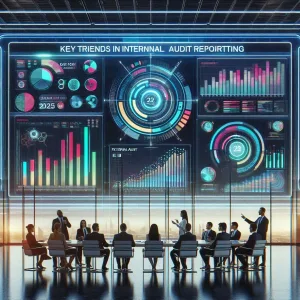In today’s digital landscape, the role of internal audit has evolved significantly, particularly in the realm of cybersecurity. Traditionally, internal audit functions have been focused on evaluating the effectiveness of an organization’s governance, risk management, and control processes. This includes ensuring compliance with laws and regulations, assessing operational efficiency, and safeguarding assets. However, as cyber threats become increasingly sophisticated and pervasive, the internal audit function is now recognized as a critical partner in the cybersecurity framework of an organization.
Cybersecurity has emerged as a paramount concern for organizations across all sectors. With the rise of data breaches, ransomware attacks, and other cyber threats, businesses are compelled to prioritize their cybersecurity measures. The stakes are high; a single breach can lead to significant financial losses, reputational damage, and legal repercussions. As such, organizations must adopt a proactive approach to identify vulnerabilities and mitigate risks associated with their IT infrastructure.
To effectively address these challenges, collaboration between internal audit and IT security teams is essential. Internal audit can provide an objective assessment of the organization’s cybersecurity posture, ensuring that controls are in place and functioning as intended. By working together, these teams can enhance the organization’s ability to respond to evolving threats, align cybersecurity initiatives with business objectives, and ultimately strengthen the overall security framework. This partnership not only fosters a culture of accountability but also ensures that cybersecurity measures are robust and dynamically aligned with the organization’s risk profile and regulatory requirements.
The intersection of internal audit and cybersecurity is critical for protecting organizations in an increasingly complex threat landscape. By leveraging the strengths of both functions, organizations can better safeguard their assets and ensure long-term resilience against cyber threats.
Understanding Cybersecurity Risks
In today’s digital landscape, organizations face a myriad of cybersecurity threats that can compromise their integrity and operational continuity. Internal audit plays a pivotal role in identifying and mitigating these risks, ensuring that organizations are not only compliant but also resilient against potential cyberattacks.
Types of Cyber Threats
- Malware: This encompasses various malicious software types, including viruses, worms, and Trojans, designed to disrupt, damage, or gain unauthorized access to computer systems. Malware can lead to significant data breaches and operational downtime.
- Phishing: A common tactic used by cybercriminals, phishing involves tricking individuals into providing sensitive information, such as usernames and passwords, often through deceptive emails or websites. This can result in unauthorized access to critical systems and data.
- Ransomware: This type of malware encrypts an organization’s data, rendering it inaccessible until a ransom is paid. Ransomware attacks have surged in recent years, causing severe financial losses and reputational damage to affected organizations.
Statistics on Cyberattacks
The frequency and sophistication of cyberattacks have escalated dramatically. For instance, recent reports indicate that:
- Cyberattacks have increased by over 400% since the onset of the COVID-19 pandemic, highlighting the urgent need for robust cybersecurity measures.
- The average cost of a data breach is estimated to be around $4.24 million, underscoring the financial implications of inadequate cybersecurity defenses.
- Organizations that experience a ransomware attack face an average recovery cost of $1.85 million, not including the potential loss of business and customer trust.
These statistics illustrate the pressing need for organizations to prioritize cybersecurity as a fundamental aspect of their operational strategy.
Importance of Identifying and Assessing Cybersecurity Risks
Incorporating cybersecurity risk assessment into the internal audit process is essential for several reasons:
- Proactive Risk Management: By identifying vulnerabilities and potential threats, internal auditors can help organizations implement preventive measures before incidents occur, thereby reducing the likelihood of successful attacks.
- Compliance and Governance: Internal audits ensure that organizations adhere to relevant regulations and standards, such as the NIST Cybersecurity Framework and ISO 27001, which provide guidelines for managing cybersecurity risks effectively.
- Continuous Improvement: Regular audits of cybersecurity practices allow organizations to adapt to the evolving threat landscape, ensuring that their defenses remain robust and effective against new types of cyber threats.
The intersection of internal audit and cybersecurity is critical for protecting organizations from the ever-growing array of cyber threats. By understanding the types of risks they face and the importance of proactive risk management, internal audit professionals can significantly enhance their organization’s cybersecurity posture.
The Evolving Role of Internal Audit
In today’s digital landscape, the role of internal audit is undergoing a significant transformation, particularly in the realm of cybersecurity. As organizations face an increasing number of cyber threats, internal audit functions are shifting from traditional compliance-focused audits to more dynamic, risk-based assessments. This evolution is crucial for ensuring that organizations not only comply with regulations but also effectively manage and mitigate cyber risks.
Transition from Traditional Compliance-Focused Audits to Risk-Based Assessments
Historically, internal audits primarily concentrated on compliance with established regulations and financial reporting standards. However, the rapid evolution of technology and the corresponding rise in cyber threats have necessitated a shift towards risk-based assessments. Internal auditors are now expected to evaluate the effectiveness of their organization’s cybersecurity programs, ensuring that they are not only compliant but also resilient against potential cyberattacks. This proactive approach allows internal audit to identify vulnerabilities and recommend improvements before incidents occur, thereby enhancing the overall security posture of the organization [2][10].
Evaluating IT Controls and Frameworks
As part of their evolving role, internal auditors are increasingly responsible for assessing IT controls and frameworks. This includes evaluating the adequacy of cybersecurity measures in place, such as access controls, data encryption, and incident response plans. By leveraging their unique access to various organizational functions, internal auditors can provide objective assurance regarding the effectiveness of these controls. This independent perspective is vital for informing the board and executive management about the organization’s readiness to address cyber risks and comply with relevant regulations, such as the SEC cyber disclosure rule [9][12].
Contributing to a Proactive Cybersecurity Strategy
Internal audit can play a pivotal role in shaping a proactive cybersecurity strategy. Here are several ways in which internal auditors can contribute:
- Risk Identification and Assessment: Internal auditors can help identify and assess cyber risks by conducting thorough evaluations of the organization’s cybersecurity landscape. This includes analyzing potential threats and vulnerabilities that could impact the organization [11].
- Control Framework Selection: By selecting appropriate control frameworks, such as the NIST Cybersecurity Framework, internal auditors can guide organizations in implementing effective cybersecurity measures tailored to their specific needs [13].
- Continuous Monitoring and Improvement: Internal audit functions can establish audit trails for data access and processing activities, ensuring compliance and transparency. This ongoing monitoring allows organizations to adapt their cybersecurity strategies in response to emerging threats and evolving technologies [3][8].
- Collaboration with IT Security Teams: By working closely with IT security teams, internal auditors can ensure that cybersecurity initiatives align with organizational goals and risk management strategies. This collaboration fosters a culture of security awareness and accountability across the organization [6][14].
The evolving role of internal audit in cybersecurity is critical for protecting organizations against the ever-growing threat of cyberattacks. By transitioning to risk-based assessments, evaluating IT controls, and contributing to proactive cybersecurity strategies, internal auditors can significantly enhance their organization’s resilience and security posture. This shift not only benefits the internal audit function but also strengthens the overall governance and risk management framework within the organization.
Collaboration with IT Security Teams
In today’s digital landscape, the intersection of internal audit and cybersecurity is more critical than ever. As organizations face increasing cyber threats, fostering collaboration between internal audit and IT security teams is essential for enhancing security measures and ensuring compliance. Here are some key points to consider regarding this collaboration:
Best Practices for Fostering Collaboration and Communication
- Establish Trust and Open Communication: The effectiveness of internal audits relies heavily on trust between the audit team, IT, and other departments. Building a culture of open communication allows for the identification of problems and the development of solutions more swiftly [1][2].
- Regular Joint Meetings: Hosting regular meetings, such as quarterly “Lunch and Learn” sessions, can facilitate knowledge sharing. During these meetings, IT can present new security protocols, while the audit team can discuss compliance changes, fostering mutual understanding and collaboration [6].
- Cross-Functional Teams: The new cyber disclosure rule emphasizes the need for greater communication among IT, security, finance, and other departments. Internal audit should coordinate with these cross-functional teams to enhance assessments and ensure comprehensive oversight of the risk landscape [9].
Supporting IT Security Initiatives Through Independent Assessments
- Independent Assurance: Internal audit functions are uniquely positioned to provide independent assurance that can enhance an organization’s cybersecurity efforts. By conducting regular audits, internal auditors can identify lapses in cybersecurity controls and recommend improvements [11][5].
- Continuous Collaboration: The internal audit team should not operate in isolation. Continuous collaboration with IT security teams allows auditors to stay updated on the latest threats and best practices, which is crucial for effective risk management [12][3].
- Proactive Risk Management: By working closely with IT security, internal audit can help prevent major cyber threats through frequent assessments and recommendations, ensuring that the organization remains resilient against evolving risks [5][2].
The collaboration between internal audit and IT security teams is not just a best practice; it is a strategic imperative for organizations aiming to bolster their cybersecurity efforts. By fostering communication, supporting initiatives through independent assessments, and learning from successful case studies, organizations can create a resilient framework that protects against cyber threats.
Key Areas for Internal Audit Focus
In the realm of cybersecurity, internal audit plays a pivotal role in safeguarding organizations against potential threats. By focusing on specific areas, internal auditors can significantly enhance the effectiveness of cybersecurity measures. Here are the key areas where internal audit can add value to cybersecurity efforts:
- Evaluation of Security Policies and Procedures: Internal auditors should ensure that comprehensive security policies and procedures are not only documented but also up-to-date and aligned with industry standards and regulatory requirements. This involves a thorough review of existing policies to confirm they adequately address current threats and compliance obligations, thereby establishing a robust framework for cybersecurity governance [4][10].
- Assessment of Incident Response Plans and Disaster Recovery Strategies: It is crucial for internal audit to evaluate the effectiveness of an organization’s incident response plans and disaster recovery strategies. This assessment should include testing the plans through simulations and ensuring that they are well-communicated across the organization. A well-prepared incident response can significantly mitigate the impact of a cyber incident, ensuring that the organization can recover swiftly and effectively [3][6].
- Review of User Access Controls and Data Protection Measures: Internal audit should conduct a detailed review of user access controls to ensure that only authorized personnel have access to sensitive data. This includes evaluating the processes for granting, modifying, and revoking access rights, as well as assessing the effectiveness of data protection measures in place. By ensuring that access controls are stringent and data is adequately protected, internal audit can help prevent unauthorized access and data breaches [10][12].
By concentrating on these key areas, internal audit functions can provide valuable insights and recommendations that bolster an organization’s cybersecurity posture, ultimately contributing to a more secure operational environment.
Tools and Frameworks for Effective Auditing
In the realm of cybersecurity, internal audit plays a pivotal role in safeguarding an organization’s assets and ensuring compliance with regulatory requirements. To enhance the effectiveness of internal audits in this critical area, it is essential to leverage established frameworks and advanced technological tools. Below are key components that can significantly bolster the internal audit function in cybersecurity.
Common Frameworks
- NIST (National Institute of Standards and Technology): NIST provides a comprehensive framework for managing cybersecurity risk. It outlines best practices and standards that organizations can adopt to improve their security posture. The NIST Cybersecurity Framework (CSF) is particularly useful for internal auditors as it offers a structured approach to assessing and enhancing cybersecurity measures.
- COBIT (Control Objectives for Information and Related Technologies): COBIT is a framework designed for developing, implementing, monitoring, and improving IT governance and management practices. It helps internal auditors evaluate the effectiveness of IT controls and ensures alignment with business goals, making it a valuable tool for assessing cybersecurity risks.
- ISO 27001: This international standard focuses on information security management systems (ISMS). It provides a systematic approach to managing sensitive company information, ensuring its confidentiality, integrity, and availability. Internal auditors can utilize ISO 27001 to assess compliance and identify areas for improvement in an organization’s information security practices.
Technological Tools
- GRC Software (Governance, Risk Management, and Compliance): GRC software solutions streamline the audit process by integrating governance, risk management, and compliance activities into a single platform. These tools enable internal auditors to automate workflows, track compliance, and manage risks effectively, thereby enhancing the overall efficiency of the audit process.
- Data Analytics Tools: Utilizing data analytics tools allows internal auditors to analyze large volumes of data quickly and accurately. These tools can identify patterns, anomalies, and potential security threats, enabling auditors to provide more insightful assessments of an organization’s cybersecurity posture. By leveraging data analytics, auditors can enhance their ability to detect and respond to risks proactively.
Training and Certification Programs
- Cybersecurity Certifications: As the demand for skilled internal auditors with cybersecurity expertise grows, pursuing relevant certifications becomes crucial. Programs such as Certified Information Systems Auditor (CISA) and Certified Information Systems Security Professional (CISSP) equip auditors with the necessary knowledge and skills to effectively assess cybersecurity risks and controls.
- Continuous Learning: Internal auditors should engage in ongoing training to stay updated on the latest cybersecurity trends, threats, and best practices. This commitment to continuous learning not only enhances their auditing capabilities but also ensures that they remain valuable assets to their organizations in the face of evolving cyber threats.
By integrating these frameworks, tools, and training programs, internal auditors can significantly enhance their effectiveness in evaluating and improving an organization’s cybersecurity measures. This proactive approach not only protects the organization from potential threats but also fosters a culture of security awareness and compliance throughout the enterprise.
Challenges and Considerations
In the realm of cybersecurity, internal audit professionals face a myriad of challenges that can significantly impact their effectiveness in safeguarding organizational assets. Understanding these challenges is crucial for both internal auditors and IT security teams as they collaborate to enhance cybersecurity measures. Here are some key challenges and considerations:
- Balancing Audit Scope with Resource Constraints: Internal audit teams often grapple with limited resources, which can restrict their ability to conduct comprehensive audits. The challenge lies in defining an audit scope that is both thorough and feasible within the constraints of time, budget, and personnel. This necessitates a strategic approach to prioritize critical areas that pose the highest risk to the organization, ensuring that essential cybersecurity aspects are not overlooked [1][8].
- Staying Up-to-Date with Rapidly Evolving Cyber Threats and Technologies: The cybersecurity landscape is characterized by its dynamic nature, with new threats and technologies emerging at an unprecedented pace. Internal auditors must continuously update their knowledge and skills to effectively assess and respond to these evolving risks. This includes understanding the implications of advancements such as cloud computing, IoT, and mobile devices, which introduce new vulnerabilities that must be addressed in audit processes [6][12].
- Managing Stakeholder Expectations Regarding Audit Findings: Internal auditors often face the challenge of aligning their findings with the expectations of various stakeholders, including management and the board of directors. There is a need to communicate audit results effectively, ensuring that stakeholders understand the significance of the findings and the necessary actions to mitigate identified risks. This requires auditors to not only present data but also to provide context and recommendations that resonate with the strategic objectives of the organization [4][11].
By addressing these challenges, internal audit professionals can enhance their role in cybersecurity, ensuring that their assessments are not only relevant but also impactful in protecting the organization from potential threats. The collaboration between internal audit and IT security teams is essential in fostering a resilient cybersecurity posture that adapts to the ever-changing threat landscape.
Conclusion
In today’s digital landscape, the intersection of internal audit and cybersecurity has never been more critical. Internal audit functions serve as essential partners in safeguarding organizations against cyber threats by conducting rigorous risk assessments, governance reviews, and compliance checks. This proactive approach ensures that cybersecurity measures are not only robust but also dynamically aligned with evolving threats and business objectives [1].
The collaboration between IT security teams and internal auditors is vital. By working together, these two groups can enhance the effectiveness of cybersecurity strategies, ensuring that vulnerabilities are identified and addressed promptly. Internal auditors play a crucial role in informing the audit committee and board of directors about the effectiveness of controls in place, which is increasingly important as organizations face growing cyber risks [3][11].
Moreover, adopting a continuous improvement mindset in cybersecurity practices is essential. Cybersecurity audits should be conducted regularly, with the frequency tailored to the organization’s risk profile and industry regulations. This ongoing evaluation allows organizations to adapt to new threats and improve their defenses continuously [4][8].
In summary, the synergy between internal audit and cybersecurity is vital for protecting organizations. By fostering collaboration and committing to continuous improvement, IT security teams and internal auditors can significantly enhance their organization’s resilience against cyber threats.
Find out more about Shaun Stoltz https://www.shaunstoltz.com/about/
This post was written by an AI and reviewed/edited by a human.



